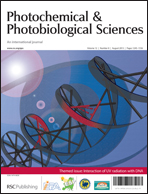The nature of electronically excited states in DNA is analyzed in detail using a combination of quantum mechanical (QM) semiempirical calculations and molecular dynamics (MD). For this purpose, we consider homogeneous π stacks extracted from the MD trajectory of a poly(A)·poly(T) oligomer. The environment is accounted for within the QM/MM scheme. The effects of structural fluctuations on exciton delocalization and photoinduced charge separation are explored using the quantitative analysis of the electron density in the excited states. We distinguish the effects generated by the vibronic interactions within nucleobases and by the environment of the π stack. While in ideal B-DNA stacks (A–T)n singlet excited states are spread over all intrastrand nucleobases, the average exciton length is ∼0.75n, thermal fluctuations decrease considerably the extent of delocalization. The QM/MD model predicts that the excitons in (A–T)n stacks are spread over 3 bases (for n = 4 and 6, the average exciton length is found to be 2.6 ± 0.3 and 2.8 ± 0.3, respectively). We show that the main factor reducing the exciton length is the vibronic interactions within nucleobases whereas fluctuations of the π stack environment play a relatively minor role. The oscillator strength of electronic transitions from the ground state to charge-separated states Ak+Ak±1− and Tk+Tk±1− is found to be strong enough to populate directly these states by UV absorption at E = 5.0–5.3 eV. In contrast, the direct formation of interstrand charge transfer states Ai+Tj− is predicted to be unlikely.

You have access to this article
 Please wait while we load your content...
Something went wrong. Try again?
Please wait while we load your content...
Something went wrong. Try again?


 Please wait while we load your content...
Please wait while we load your content...